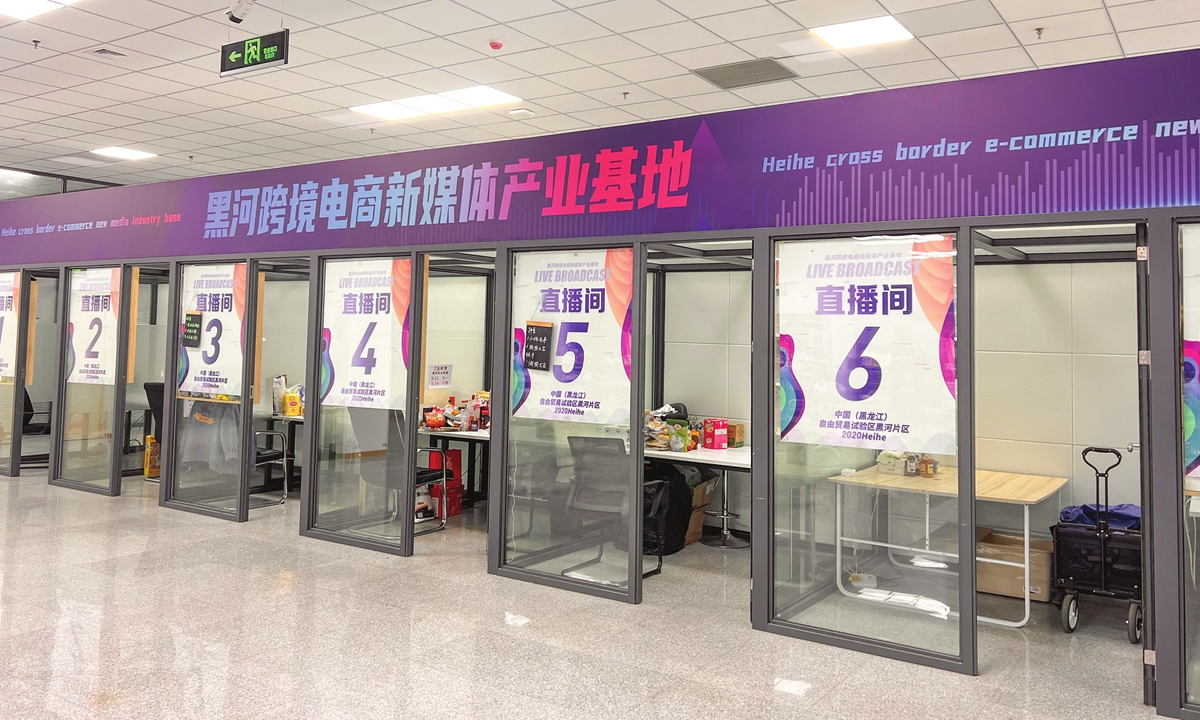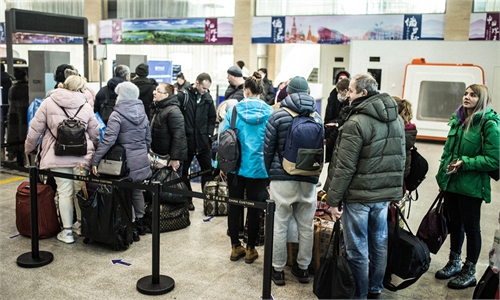Livestreaming gives a lift to e-commerce
Border cities like Heihe, Hunchun see a surge in trade

Zhang Jian hosts a livestreaming session in the Heihe cross-border e-commerce livesteaming base. Photo: Courtesy of Zhan Yucheng
While traditional cross-border trade between China and its neighbors was affected during the COVID-19 pandemic over the past three years, e-commerce services had emerged becoming a major channel for commerce, which also withstood the most pressure to protect the country from imported infections, while stabilize the foreign trade and boost the economy.
In 2022, the total transactions of the cross-border e-commerce industrial park in Heihe, a border city between China and Russia in Northeast China's Heilongjiang Province, exceeded 1 billion yuan ($146 million), with online retail sales reaching 323 million yuan, Heihe local authorities confirmed.
In Hunchun, an important border city in Northeast China's Jilin Province which neighbors Russia and North Korea, the value of e-commerce import and export trade increased from 43 million yuan in 2018 to 2.15 billion yuan in 2021. From January to October 2022, the e-commerce imports and export s in Hunchun city reached 2 billion, recording a year-on-year increase of about 77.5 percent, people.com.cn reported.
"The pandemic impacted cross-border movement of people, but on the other hand, it accelerated the circulation of goods through cross-border e-commerce platforms," Sun Jufeng, an official from the international cooperation pilot zone, said.
With effective pandemic prevention and control measures in place in 2022, the ports in Hunchun maintained stable operation last year. Goods continued to flow to Hunchun from nearby ports that were halted due to the COVID resurgences, Sun said.
Hunchun, administered by the Yanbian Korean Autonomous Prefecture, has four ports, two serving Russia and two serving North Korea. With Hunchun acting as a distribution center, international logistics operators can realize sea-railway-land combined transport.
Goods from Russia, Japan, South Korea and South America can arrive at the nearby ports and be transported into China, and vice versa, the Global Times learned from local officials.
Thanks to its unique location, Hunchun seized the opportunity to expand its local e-commerce sector starting from 2017, a trend that was accelerated despite the pandemic in the past three years.

A woman hosts a livestreaming session in the Heihe cross-border e-commerce livesteaming base. Photo: Leng Shumei/GT
Important business toolCross-border e-commerce has become an important tool in stabilizing foreign trade and promoting consumption, thanks to its advantages including online transactions, contactless delivery and relatively short transaction chain.
It has significantly lowered the specialization threshold for international trade, enabling a large number of small-sized and micro entities to become new trade operators. It also represents a new path to promote consumption upgrade. Being decentralized, globalization can meet consumers' needs for tailor-made products, analysts noted.
Data from Chinese customs showed that the country's import and export scale of the cross-border e-commerce increased nearly 10-fold in the past five years, and its share in foreign trade rose from less than 1 percent in 2015 to 4.9 percent in 2021.
In November 2022, China approved the establishment of comprehensive pilot zones for cross-border e-commerce in 33 cities and regions across the country, in a bid to leverage the positive role of cross-border e-commerce in facilitating transformation, upgrading and digital development of traditional industries and to optimize China's foreign trade.
The country set up its first comprehensive pilot zone for cross-border e-commerce in 2015, and has since expanded the number of industrial zones several times. The number of comprehensive pilot zones for cross-border e-commerce has reached more than 100 now across the country.

A view of Heihe cross-border e-commerce livesteaming base Photo: Leng Shumei/GT
Livestreaming boomAmid an e-commerce boom during the pandemic in the past years, livestreaming took off and became a popular shopping method for Chinese consumers.
About 6 million orders had been made on the cross-border trade livestreaming platform belonging to the Heihe cross-border e-commerce industrial park in 2022 alone, with the aggregate sales value hitting 180 million yuan, according to Heihe authorities.
The outbreak of COVID-19 in early 2020 has inspired many small and medium-sized e-commerce companies in the park to turn to livestreaming as a new sales channel, so that people could grasp the opportunity to build a cross-border e-commerce livesteaming base, Zhan Yucheng, deputy director of the foreign trade and cooperation center of the Heihe free trade zone, told the Global Times.
The base has attracted about 30 companies and 130 hosts. The yearly sales amount of the base reached a total of 150 million yuan in the past three years, according to Zhan.
Zhang Jian, a host working at the Heihe livestreaming base, told the Global Times that sales of his live stream sessions were equal to about 6 million yuan in 2022 and are expected to exceeded 7 million yuan in 2023, following the government's optimization of COVID-19 management in December.
The best-selling goods at Zhang's livestreaming sessions are sweets and milk powder from Russia and Belarus, according to local media reports.




